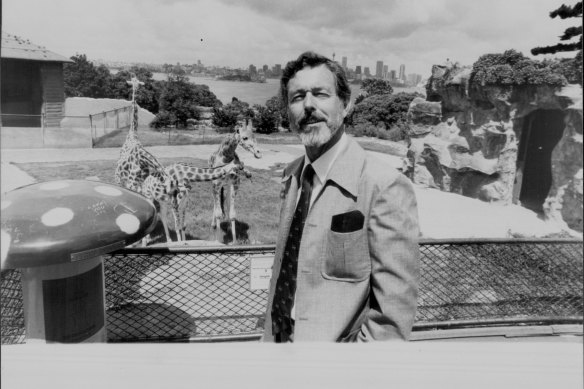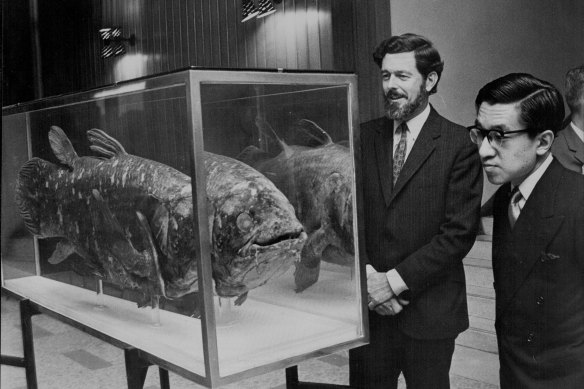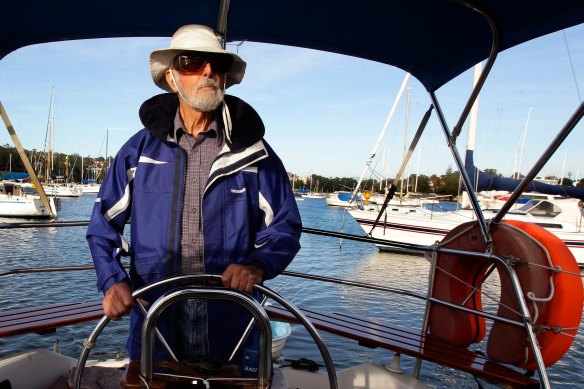On the founding of Lizard Island Research Station, he wrote that it was believed that the coral reef and rainforest was thought to be unchanging. “One Tree Reef did not behave, however: species and populations of fishes changed from year to year. We talked of this at international meetings – and were ridiculed by our American friends. One coral reef scientist introducing me at a meeting in Miami, said: ‘You are going to hear strange things from Frank, but then, in the antipodes, Australians do stand on their heads’. Our counts showed great annual changes, species sometimes disappeared, and all the fishes bred at the same time of year.‘Why?’ we asked ourselves.”
An internationally renowned museum director and the only Australian to lead the prestigious Smithsonian Institution’s National Museum of Natural History in Washington, DC, a role he held from 1989 to 1994. Talbot also served as executive director of the California Academy of Sciences in San Francisco from 1982-1989.
He was also the founding chair of the Sydney Institute of Marine Science (SIMS), a leading marine research centre, founding professor of environmental studies at Macquarie University, and a former chairman of the Taronga Zoo board and the North American Association of Science Museum Directors.

Frank Talbot, professor of marine biology and chairman of Taronga Park Zoo board, 1982.Credit: Fairfax Media
His influence extended far beyond the walls of the institutions he led. An expert in marine biology, he was a pioneering researcher in coral reef ecosystems, contributing significantly to global understanding of marine life and the urgent need for its conservation.
Talbot’s groundbreaking research on coral reefs in the Red Sea and across the Indo-Pacific brought critical attention to these fragile environments long before the current global awareness of climate change and ocean conservation.

Director Frank Talbot with the visiting crown prince of Japan at the Australian Museum in 1973.Credit: George Lipman/Fairfax Media
“Frank’s vision wasn’t just about understanding the past, it was about inspiring the future, and the establishment of the AM’s Lizard Island Research Station is one of Professor Talbot’s most notable achievements,” Australian Museum chief scientist and director of AMRI, Professor Kris Helgen said.
“The museum owes so much to Frank. When he founded the Lizard Island Research Station 51 years ago, it began as a series of tents and a few modest buildings on the beach, which has now grown to become a globally recognised research station devoted to understanding the incredible scale and structure of the Great Barrier Reef, a natural history icon seen from space.”
Dr Anne Hoggett, co-director of the Lizard Island Research Station, said: “Frank was a trailblazer for scientific exploration of coral reefs, establishing not only Lizard Island Research Station, but also One Tree Island Research Station at the southern end of the Great Barrier Reef.”

Coral reef scientist Frank Talbot in 2009.Credit: Adam Hollingsworth
“We are committed to honouring Frank’s legacy by continuing the vital research at Lizard Island, welcoming hundreds of scientists from all over the world every year to help understand coral reefs,” Dr Lyle Vail, co-director of the Lizard Island Research Station said.
In 1978, when the LIRS was in its infancy, the Lizard Island Reef Research Foundation was established to support research and education. The foundation was established by Dr Des Griffin AM, who succeeded Talbot as director of the Australian Museum from 1976-1998.
“Frank was the first person I met in Sydney in May 1966 when I arrived to take up the job of assistant curator of marine invertebrates at the Australian Museum,” Griffin said.
“He told me not long ago that he didn’t want to be made a fuss of, he just wanted to get on and make a difference, and I think we can all agree that he has made a difference and will continue to do so through his lasting legacy,” Griffin added.
Loading
As an educator and mentor, Talbot shaped the careers of countless scientists, many of whom have become leaders in their fields. His ability to blend rigorous scientific research with an infectious enthusiasm for discovery inspired students, colleagues, and the public. Even after retirement, he remained a passionate advocate for science.
Born in South Africa, Talbot’s career began with studies in zoology and a fascination with the ocean that would come to define his life’s work. He received his PhD from the University of Cape Town in 1959. His early research in the 1960s contributed to a growing body of knowledge about the complexity and vulnerability of coral reefs.
In recognition of his contributions, Talbot was awarded numerous honours, including being made a Member of the Order of Australia in 2012.
“I feel lucky to have been good friends with Frank. In fact, my first radio piece in 1972 was editing an interview about coral on One Tree Island with Frank when he was the director of the Australian Museum,” said president emeritus of the Australian Museum Trustees, Robyn Williams AO.
“I was with him many times overseas, especially in America, and was struck by the access and respect Frank received from top politicians. In Washinton, DC, standing on the steps of the Smithsonian Natural History Museum, we looked up the hill at the US Capitol. “I spend so very much time up there, getting things done,” he recalls Frank saying with a smile.
Professor Tim Flannery, who spent much of his career leading the mammal section at the Australian Museum, noted that “Frank was a giant in science and in the museum world. He was the model to which I’ve tried to shape my career, and he leaves a gap that can never be filled.”

Frank Talbot on his Phantom 33 yacht, Pot of Gold, in Woodford Bay near Longueville in 2013.Credit: Dallas Kilponen
Frank was married for 70 years to marine scientist Sue, who predeceased him in 2020. He is survived by daughter Helen Kottler and sons Bill, Jonathan and Nick Talbot.
Professor Talbot was a visionary whose contributions to both academia and public education have left an enduring legacy.
A longer version of this obituary appears on the Australian Museum website.
Get to the heart of what’s happening with climate change and the environment. Sign up for our fortnightly Environment newsletter.


